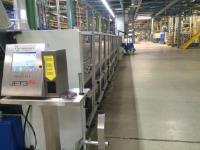 Add My Company
Add My Company
Sign In
The need for speed – can printing
01-03-2018

The need for speed – can printing
Can-pack, one of the UK’s largest manufacturers of aluminium cans for the beer and beverage industry, approached us at ATD for a solution to a unique requirement for can printing.
Having one of the world’s fastest aluminium can production lines, with productions speeds of up to 8m/sec, Can-pack produces 54 cans every second. Their can printing requirement was to print onto the base of each can using an invisible UV readable ink. There were many issues to overcome, mainly the speed of production and the temperature of the cans.
Can-pack can printing production line
Their production line set up has 15 forming stations and within each forming station is a forming star wheel holding 12 cans. The star wheels rotate at up to 8 metres per second and transfers each can from one star wheel to the other and so on down the can forming line.
The location of a can on the forming star wheel is synchronised so that can position 1 on the first forming star wheel is the same as can position 1 on the last forming star wheel.
Canpack’s can printing requirement of applying the invisible UV readable code to the base of each can meant using sequential numbers from 01 to 12 to coincide with the can position in the star wheel and continuously repeat this sequence.
At ATD, we suggested the solution was to use the Leibinger Jet 3 UP printer, configured with their unique sterilisable UV readable ink. Can-pack were keen to hear more and invited us to visit them to conduct a full trial.
The trial was very successful, however, there were a number of engineering challenges we had to overcome. The first being how to detect the chamfered bottom edge of a reflective aluminium can travelling at 8m/sec and with a detection requirement of 54 cans per second. It was a tricky one, but working closely with our supply partner OEM Ltd, and after testing a number of their laser detectors, we found a reliable solution.
Can-pack can printing solutionThe second challenge we faced was synchronising the printed sequential number with the correct can position. We were able to solve this by attaching a metal plate to the end of the star wheel drive shaft and using an inductive detector to reset the Leibinger’s sequential counter. The variable speed of the production line as it accelerated and decelerated from zero to 8m/sec was synchronised with the Jet 3UP CIJ printer, by connecting a shaft encoder to the star wheel drive shaft.
Lastly, the environment where the Jet 3 UP print head is installed is very harsh, the temperature rises to 40ºC and the moving parts are well lubricated. There is the potential for the lubrication to enter the Jet 3 UP print head. This was another ticky issue for us but we were able to overcome it by installing a pumped air supply directly into the print head cavity.
The pumped air provided a continuous over-pressure within the print head cavity, all whilst the printer and production line is running, preventing lubricant from entering the print head and additionally providing cooling. This over-pressure system is a standard cost option for the Jet3 UP printer.
The results we were able to achieve completely hit the spot. Printing is clearly readable under UV light and the Jet 3 UP has been running reliably and successfully for a number of months now.
Can-pack has even requested additional Leibinger Jet 3 UP printers for their other production lines.
For more information on The need for speed – can printing talk to ATD Marking Systems Ltd
Enquire Now
List your company on FindTheNeedle.
